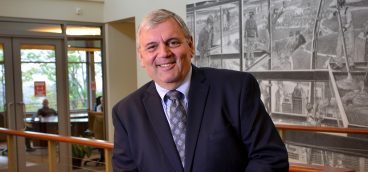
When Melia Tourangeau joined the Pittsburgh Symphony Orchestra as President and CEO in July 2015, she immediately faced a problem she hadn’t anticipated: massive debts from a nearly insolvent pension program. Last fall, the PSO endured a 55-day strike that ended when two donors made one-time gifts and musicians agreed to concessions. Tourangeau discusses the problems that remain and the path forward.
Q. When you joined the PSO in July 2015, to what degree were you aware of any financial problems?
A. I was certainly aware there were challenges here, especially on the earned revenue side of the equation—the ticket side. With the recession, things bottomed out for everyone. There was a million or million and a half deficit the year before I came. My first day on the job, there was a finance committee meeting and we were looking at the same deficit for the 2015–16 fiscal year. I thought that was my challenge— eradicating that deficit.
When you get your arms around an organization, you find more challenges than you anticipated. I was prepared for that. But what was new to me was owning our own pension plan. In past organizations, retirement programs were 401ks or multi-employer pension plans through the national union. In both, you can budget the retirement amount—it’s just money out the door and you don’t have to worry about it. Owning your own pension is a lot more complicated. And the organization did a very responsible job in managing the pension challenges for a number of years. However, no one would have anticipated that interest rates would be this low for almost a decade.
The pension was the debilitating factor. The cash need for the pension over the next five years is what made it such a dire situation. At the time of the strike—and the union and board/ management had differing views on the size of the problem— it was between owing $8 million to $10 million over the next five years. In addition, we have $5 million in pension loans.
Q. How did management and the board decide what steps to take to address the problems? Can you explain what you felt was necessary to accomplish?
A. Once I found out the scope of the challenge, I wanted to be sure the entire board was aware. We held seven smaller board meetings with eight to 10 board members in each meeting. I was charged to put together a five-year budget projection. And when we put the numbers together, the gap was pretty scary. Before moving forward, I needed guidance from the board.
The board had been so focused on recovering from the Great Recession and the year-to-year planning, that many trustees didn’t know the extent of what we were facing. Those meetings really instructed our plan for negotiations. It was really difficult for me personally—my first year with one of the best orchestras in the world and facing a very difficult situation. After we took the scenario to all our major funders for additional transparency and help, it was clear that we needed some relief from the orchestra—and that was the mandate from the board. From our perspective, it was evident that this needed to be a concessionary agreement.
Part of the challenge was the transparency to the musicians. You want to portray a positive image and one of growth, enthusiasm and success—going in with a doomsday scenario doesn’t inspire giving. In my first year, it was a really tough balance for me. A lot of work needed to be done, and I had to be careful about what was being communicated, especially to the broader public.
Q. Do you feel that the public—and for that matter, the musicians—had a clear understanding of what the issues were and are?
A. Certainly not before the negotiations. Once things went public, there was a much better understanding. I’m absolutely grateful for the sacrifice the musicians have given us. We have to continue to make clear that that contribution from the orchestra and their sacrifice didn’t solve the problem. However, our intent is to leverage it in every way possible in our greater fundraising efforts over the next five years. I really do believe that, framed in a compelling way, the community will respond.
Q. You settled after a 55-day strike, and the intervention of two donors to once again fill the gap with short-term gifts. The settlement appears to have been far short of what management hoped to achieve. Does it represent a step toward solving the financial problems?
A. Certainly yes. It’s allowing us some breathing room on a cash basis to find the support in the community that we need. I know there’s been a lot of criticism—are you just kicking the can down the road again? I would say, technically, yes. However, I believe in my own fundraising and management skills. And we’ve put a great case together with our strategic plan, and the way we’re going to position the PSO moving forward will inspire new and additional giving.
Q. What still needs to be done to put the PSO on a solid financial footing? What are your options and what will you be pursuing?
A. We have an extensive strategic plan. The main pillars are audience development —building our subscriber base back up. We have a five-year plan to build our subscribers to 55 percent of the house for the BNY Mellon Grand Classics; currently we’re at 35 percent.
Those loyal patrons are our donors and our future donors. That’s where the individual giving is going to be; it’s our greatest prospect pool. The real success will be in our fundraising efforts, but we have to give people a good reason to support us.
How we engage in the community beyond Heinz Hall is a big part of that. Heinz Hall should be owned, figuratively speaking, by the community and be an open and welcoming space. It can be an intimidating space. Some people may feel, “It’s not for me—it’s for the symphony.” It is a beautiful space, but it should be beautiful for everybody. That’s the fun part of this job—breaking down the stereotypes of what the symphony is and who they are as individuals.
“I know there’s been a lot of criticism —are you just kicking the can down the road again?”
—Melia Tourangeau President & CEO, Pittsburgh Symphony Orchestra
I firmly believe we don’t have to change anything on stage. But how we market, communicate with patrons and interact with Pittsburgh has to change in order to be seen as the relevant, vibrant institution that we are.
We’re an important part of the cultural fabric of Pittsburgh, one of the crown jewels of this city. And there’s a lot of community pride here. The musicians would say that the PSO really “punches above its weight,” and when you talk to people about Pittsburgh, they say the same thing about Pittsburgh. It’s about connecting those dots.
Q. How do you mend relations with the musicians?
A. We’re starting some focus groups with the staff, the board, the orchestra and the volunteers and really asking how did we get here? Why did this happen? By the spring, my plan is to have an ongoing strike recovery task force.
The other piece that’s really important is that there’s so much enthusiasm and energy from the musicians from the work they were doing with the community. They and we want to be able to engage and work with them more intentionally and strategically to move our goals forward.
With the comeback concert and the Highmark Holiday Pops, the musicians greeted our patrons, and they’re going to continue that. We’ve talked about bringing patrons back stage, so people can get to know the musicians better, and we’ve discussed using social media in even more strategic ways.
Having the musicians involved is a huge step. We now have musicians involved on every board committee, to help with communication and the transparency piece. I’m also going to do town hall meetings with musicians participating in the agenda so that I am addressing what they want to hear about.
There’s a silver lining. The musicians didn’t understand the impact they can have out in the community. We’ve been saying it for a long time—“You’re our greatest assets, our stars.” A certain number understood, but now that’s a much greater number engaged in community performances, and we want to keep that energy going.
I’ve come to appreciate the musicians’ position more since New Year’s. My initial reaction was to take it personally. Of course I didn’t create the situation—it landed on my lap, and I needed to manage it. I learned that the musicians’ position was really one of principle—wanting to maintain the crown jewel that this orchestra is and not letting it become a mediocre band. We all want this. And I believe we were both fighting for the same thing.
But there was a lot of fear among the musicians that management and the board didn’t feel the same way. My challenge is to demonstrate to the musicians that we do, that we are aligned in wanting to keep this orchestra at the highest caliber. And we need to demonstrate that to Pittsburgh.




